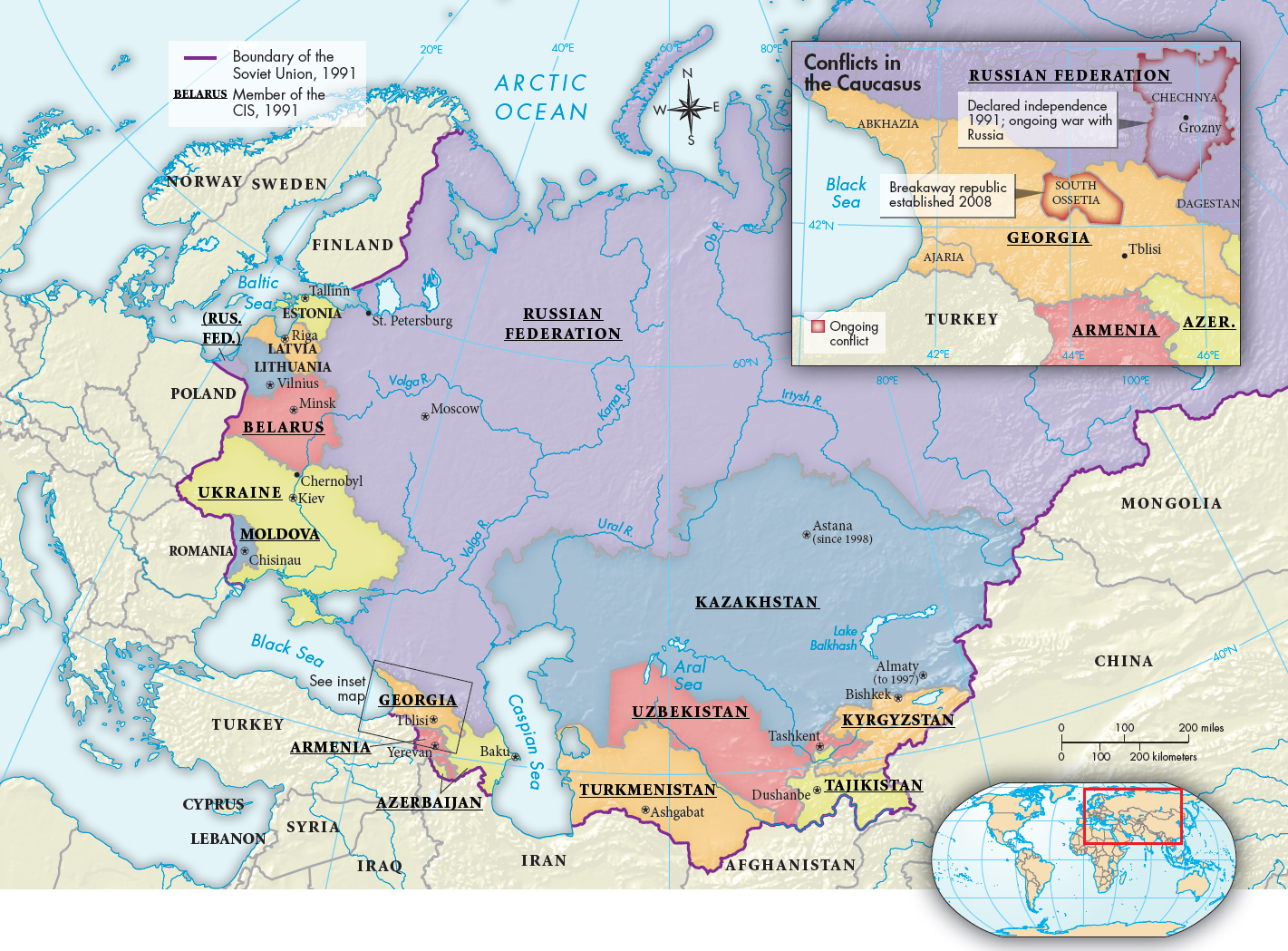Understanding World Societies:
Printed Page 1019
Chapter Chronology
Recasting Russia Without Communism
Amid anticommunist upheavals in eastern Europe, the Soviet Union itself transitioned away from Communist Party rule. In February 1990 the Soviet Communist Party was defeated in local elections throughout the country. Gorbachev responded by asking Soviet citizens to ratify a new constitution that abolished the Communist Party’s monopoly on political power and expanded the power of the Congress of People’s Deputies. Gorbachev’s eroding power and unwillingness to risk a popular election for the presidency strengthened his rival, Boris Yeltsin (1931–2007), the former mayor of Moscow. In May 1990, as leader of the Russian parliament, Yeltsin announced that Russia would declare its independence from the Soviet Union. In June 1991 Yeltsin was elected president of the Russian Federation within the Soviet Union, placing him in direct confrontation with Gorbachev, who wanted to keep the Soviet Union together amid carefully managed reforms.
In August 1991 Gorbachev survived an attempted coup by Communist Party hardliners and their allies in the armed forces. Not only did their coup attempt fail, but it also hastened the end of the Soviet Union. Yeltsin emerged as a popular hero for his dramatic resistance to the coup attempt.
In the aftermath of the attempted military takeover, an anticommunist revolution swept the Russian Federation as the Communist Party was outlawed and its property confiscated. Yeltsin and his liberal allies declared Russia independent and withdrew from the Soviet Union. All the other Soviet republics followed suit. Gorbachev agreed to their independence, and the Soviet Union ceased to exist on December 25, 1991 (Map 32.3).

MAP 32.3Russia and the Successor StatesAfter the attempt in August 1991 to depose Gorbachev failed, an anticommunist revolution swept the Soviet Union. Led by Russia and Boris Yeltsin, the republics that formed the Soviet Union declared their sovereignty and independence. Eleven of the fifteen republics then formed a loose confederation called the Commonwealth of Independent States, but the integrated economy of the Soviet Union dissolved into separate national economies, each with its own goals and policies.
As Boris Yeltsin presided over newly independent Russia, he sought to create economic conditions that would prevent a return to communism. Yeltsin opted for breakneck liberalization. This shock therapy, which followed methods similar to radical free-market policies in Chile and other parts of Latin America, freed prices on 90 percent of all Russian goods. The government also launched a rapid privatization of industry and turned thousands of factories and mines over to new private companies. However, instead of producing the hoped for prosperity, prices soared and production collapsed.
Rapid economic liberalization had harsh consequences for Russia. Powerful state industrial monopolies became powerful private monopolies that cut production and raised prices in order to maximize profits. The managerial elite worked with organized crime to prevent the formation of would-be competitors. A new capitalist elite acquired great wealth and power, while the vast majority of people fell into poverty. As the quality of public services and health care declined, life expectancies fell. In 2003 Russia’s per capita income was lower than at any time since 1978, essentially erasing the economic progress gained over the past twenty-five years.
The election of Yeltsin’s handpicked successor, President Vladimir Putin (b. 1952), in 2000 ushered in a new era of “managed democracy.” Putin’s stress on public order and economic reform was popular, even as he became progressively more authoritarian. Putin consolidated the power and authority of the state around himself and his closest advisers, closing off the development of democratic pluralism and an independent legal system in Russia.
Putin carried out a brutal military campaign against the primarily Muslim republic Chechnya (CHEHCH-nyuh) (see Map 32.3, inset) that in 1991 declared its independence. Up to two hundred thousand Chechen civilians are estimated to have been killed between 1994 and 2011. Many more became refugees. Chechen resistance to Russian domination continued, often in the form of attacks such as a suicide bombing at Moscow’s airport in 2011.
Unable to run for re-election in 2008, Putin handpicked a successor, Dmitry Medvedev, to be president, and took the position of Russian prime minister for himself. He remained the main power broker and returned to the presidency in 2012. Liberal reforms doomed much of Russia’s industry, and its economy depended increasingly on oil and natural gas exports.
Political and ethnic divisions threatened peace and stability among the post-Soviet republics. Rival claims between the Republic of Georgia and the Russian Federation over the territory of South Ossetia led to war in 2008 in which Russian forces quickly defeated their Georgian rivals and established the pro-Russian autonomy of the region. In Ukraine, in 2014 pro-Western protesters toppled a president who refused to sign agreements with the European Union. In the aftermath of the uprising, Russian forces occupied Ukrainian province of Crimea along the Black Sea and backed secessionist movements in ethnically Russian regions of the Ukraine.
